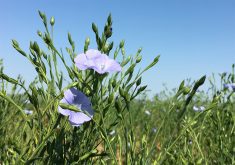Statistics Canada expects 689,000 acres of the crop will be planted this spring, an 11.6 percent drop from a year earlier
WINNIPEG (MarketsFarm) — Blue flowery fields of flax will be fewer and far between in Western Canada, according to Statistics Canada’s first survey-based seeding intentions report for 2023-24.
In a report released late last month, StatsCan projected only 689,000 acres of flaxseed to be planted this spring, an 11.6 percent decrease from the year before. More significantly, the total number of flax acres would be the fewest since 1950.
While flaxseed area in Manitoba is expected to expand 40 percent to 71,200 acres, Saskatchewan and Alberta were projected to see declines of 11.7 and 31.6 percent to 527,300 and 88,000 acres, respectively.
Read Also

Huge Black Sea flax crop to provide stiff competition
Russia and Kazakhstan harvested huge flax crops and will be providing stiff competition in China and the EU.
Greg Sundquist, chair of the Saskatchewan Flax Development Commission (SaskFlax), said StatsCan’s estimate for flax acres is “very close.” He said that while flax prices are doing well, prices for other commodities were outperforming it.
“Canola, wheat, barley — with the pricing there, we haven’t been able to attract acres,” Sundquist added. “The people that grow flax really like to grow flax. Flax can be very profitable as other crops right now.”
Other issues that have continued to deter growers from flax include variable yields and the removal of flax straw after harvest, according to Sundquist.
Canadian flax has been effectively shut out of the European and Chinese markets because of the influx of cheaper products from Russia and Kazakhstan. As a result, the Canadian flax market has focused on satiating U.S. food demand and its own.
“We’re supplying the U.S. for their needs and Canadian needs. Flax has gotten to be more of a food (product) just due to the health benefit of flax and that translates into human food, pet food, livestock food and a lot of it is going into the U.S.,” Sundquist said, adding that Canada’s flax industry is trying to break into the Mexican market.
He said flax is disease resistant compared to canola, as well as cheaper to grow and can be quite profitable. He said the lack of flax acres will become a temporary setback.
“It depends on the markets (and) what prices have to go to in order to attract more flax acres,” Sundquist said. “Is it a permanent thing? I’m not sure. Is it a temporary thing? I hope so.”

















